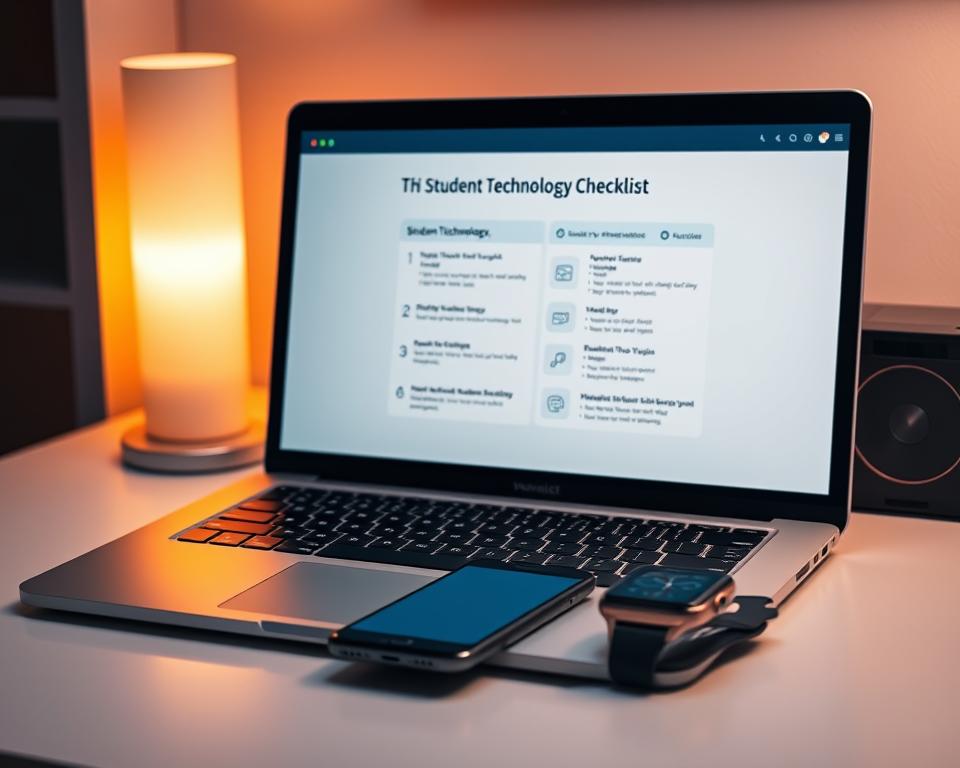Anúncios
Can a small device on your wrist change how you learn, move, and stay healthy?
Right now, the global market is shifting fast. In 2024 it hit USD 84.2 billion and could reach USD 186.14 billion by 2030, with a 13.6% CAGR through 2030. North America drives much of that growth, and wrist-worn products earned 58% of revenue last year.
Breakthroughs in materials and sensors are making gear thinner, softer, and smarter. Think bioresorbable circuits, liquid metal conductors, 2D materials, and sensors that track glucose and sweat.
You’ll get clear guidance on where the biggest opportunities sit and how these shifts affect your buying choices over the next 12–18 months. This guide pairs market numbers with practical tips so you can spot products that deliver better comfort, battery life, and accuracy.
Key Takeaways
- Market size and growth show rapid expansion and stronger U.S. leadership.
- Wrist-worn devices lead revenue, but rings, glasses, and headsets are evolving.
- Materials and sensors are moving from labs into real products.
- AI transforms raw data into useful, personal guidance for daily use.
- Prioritize comfort, battery, and sensor accuracy when you shop.
Why wearable tech is surging right now in the U.S. market
More Americans now expect their gadgets to track health and give useful feedback every day.
The U.S. market is growing because consumers want quick, nonclinical checks and clear guidance. Wrist-wear drove 58% of revenue in 2024 as people used heartbeat, sleep quality, blood oxygen, blood pressure, calories, and step counts to manage daily life.
Battery life, water resistance, and tougher builds let you wear devices around the clock. Tight phone integration and audio upgrades like active noise cancellation add lifestyle value during commutes and workouts.
“You get devices that nudge better habits, surface trends, and give coaching—not just raw numbers.”
- Convenience: quick health checks without clinical friction.
- Durability: longer battery life and water resistance for 24/7 use.
- Integration: ecosystem growth from Apple and Google smooths daily routines.
These factors raise demand for advanced devices and help the broader wearable technology market scale fast. Expect the U.S. technology market to keep expanding as fitness and health use cases deepen.
Market outlook: Growth, demand drivers, and where you’ll see the biggest gains
Steady consumer demand and richer feature sets are pushing the market toward double-digit growth.
Key figures at a glance
USD 84.2B in 2024 and projected to reach USD 186.14B by 2030 at a 13.6% CAGR. This growth rate means more frequent product updates and broader feature rollouts.
- The global wearable technology market is expanding fast; wrist-wear held 58% of revenue in 2024.
- Expect steady expansion through 2030 as demand compounds and new use cases move mainstream.
- These figures give you clear information to time upgrades and evaluate new releases.
North America’s lead and U.S. runway
North America held a 34% share in 2024, and the U.S. will capture much of the upside from 2025 to 2030.
- Top brands—Apple, Samsung, Google, Garmin—will keep pushing better sensors and smoother integration.
- Consumer electronics will stay the revenue core, while healthcare development adds higher-value use cases.
- Expect premium tiers to innovate and mid-tier models to absorb last year’s flagship features.
“The market growth fuels new products that deliver clearer insights and more everyday value.”
wearable technology trends shaping your next device choice
Generative AI is turning raw signals into simple, usable guidance so you can act without guessing.
Smartwatches still drive category momentum, but AI is what changes the user experience. Advanced sensors like ECG and SpO2 are now common across price tiers. That means better tracking and richer data for everyday choices.

From tracking to coaching: Generative AI and personalized insights
AI now gives health scores and tailored recommendations based on your routine. You’ll get concise summaries that say what to prioritize and when to rest.
On-device assistants answer questions like, “Why did my score drop?” and adapt plans to fit your schedule. Expect smarter alerts that cut noise and only prompt you for meaningful changes.
- AI fuses data across your watch, ring, earbuds, and glasses for context-aware suggestions.
- Health features expand beyond steps to include sleep staging, stress trends, and readiness insights.
- Privacy-forward processing shifts work to the device, keeping sensitive metrics local and fast.
“The move from tracking to coaching makes devices genuinely helpful every day.”
Materials and design innovations redefining comfort, accuracy, and form
New materials are changing the way you wear sensors—making them softer, lighter, and more accurate.
Transient and bioresorbable electronics operate for a set period and then dissolve safely. That means fewer follow-up procedures and simpler recovery for short-term medical uses.
Gallium-based liquid metal conductors pair with polymers to keep signals clear while stretching. They stay biocompatible and conformal, so measurements remain stable when you move.
2D materials enable thin, durable layers that scale into everyday products. Combined with soft substrates, these materials let sensors sit like a second skin.
- You’ll wear lighter, softer gear that improves comfort and sensor contact for better accuracy.
- Medical implants can work temporarily, then disappear—reducing surgeries and risk.
- E-tattoos, smart contact lenses, and battery-free organ interfaces open new clinical and at-home use cases.
- Design will favor breathability, hypoallergenic surfaces, and reliable skin adhesion for 24/7 wear.
“Materials and form factors are the fast lane in development for future wearables.”
Bottom line: these innovations put comfort and clinical-grade sensing in reach, changing the way devices fit into daily life and care.
State-of-the-art sensors unlocking deeper health monitoring
Next-gen sensors are turning simple readings into continuous, clinical-grade signals you can act on.
These advances push a device from passive tracking to active health monitoring. You get clearer signals with less fuss. That change affects daily care, workouts, and clinical workflows alike.
Glucose sensing evolution toward closed-loop diabetes management
Electrochemical glucose sensors now move toward noninvasive or minimally invasive monitoring. That progress supports continuous glucose management and the development of closed-loop artificial pancreas systems.
Real-world tie-in: Garmin enabled Dexcom CGM data on compatible cycling computers and smartwatches, giving in-workout glucose visibility that helps people adjust effort and fueling.
Sweat analytics for continuous, noninvasive precision health
Sweat sensors have improved extraction and on-skin comfort. They analyze hydration, electrolytes, and stress markers passively during workouts and recovery.
This means better insights without needles and more usable, on-device summaries that guide recovery and fueling choices.
Haptic human-machine interfaces for immersive, intuitive control
Soft sensors and micro-actuators add tactile feedback that feels natural. Haptic HMIs let you “feel” notifications, controls, and virtual textures without looking at a screen.
In practice, haptics improve remote surgery, fitness cues, and immersive apps by turning raw data into touch-based prompts and confirmations.
- You’ll see glucose tracking become more seamless with closed-loop management.
- Sweat systems will surface hydration, electrolytes, and stress markers passively.
- Heart rate and sleep insights get clearer as optics, contact surfaces, and algorithms improve.
- Multiparameter patches will merge heart, respiration, temperature, and glucose into one dashboard.
“Better sensors mean better, actionable nudges—so you can act on health signals faster.”
Bottom line: as sensor accuracy and on-device analytics improve, you’ll trust these systems more for healthcare and daily health decisions. Expect more seamless monitoring and concise guidance from the next generation of devices.
Device category outlook: What’s winning, what’s emerging, and why it matters to you
As the market matures, you’ll pick by use case: broad utility, immersion, or subtle, always-on tracking.
Wrist-wear dominance (58% share)
Smartwatches lead fitness, health, and connectivity
You’ll likely choose a smartwatch first because it bundles bright screens, apps, and top-tier sensors in one device.
Wrist-wear captured over 58% of revenue in 2024 and is the go-to for heart rate, sleep, calls, and music control.

Eyewear and headwear: AR/VR and immersive experiences
Smartglasses and headsets are primed for fast growth. Apple’s Vision Pro (2023) raised the bar with ultra-high-resolution displays and a dual-chip design that pushed mixed reality forward.
Expect smartglasses to offer gesture controls, hands-free translation, and real-time sharing. These devices reshape how you work and play with more immersive experiences and glanceable prompts.
Smart rings and body-wear: Lightweight tracking meets everyday design
Smart rings are gaining traction for subtle, 24/7 recovery and sleep insights without bulky screens. You may prefer a ring when you want passive readiness data and minimal interruptions.
Body-wear—shirts, patches, and straps—serves niche use cases like high-accuracy sport tracking or targeted rehab. Over time, categories will cross-pollinate: rings inform readiness, watches handle interactions, and glasses bring contextual prompts.
“You’ll get more choice across budgets, with premium flagships and value devices improving yearly.”
- Why it matters: you’ll pick by daily value—interaction, insight, or invisibility.
- Table-stake features on mainstream watches include fall detection, SOS, navigation, and tap-to-pay.
- Across the market, better sensors and comfort will lengthen sessions for AR/VR and fitness alike.
Connectivity, AI, and experiences: How new features change your daily use
Faster links and smarter on-device AI are turning daily sensors into helpful companions. You get clear, short prompts instead of raw charts. Your metrics move with you, not the other way around.
Always-on health: Heart rate, blood oxygen, sleep staging, stress trends
Your watch and ring deliver continuous heartbeat monitoring, blood oxygen, sleep quality, blood pressure, calorie burn, and steps. Improved sensor design and signal processing give more stable heart rate and SpO2 tracking during workouts and daily life.
You’ll see sleep staging and stress trends roll into simple scores and practical tips. That makes monitoring less noisy and more useful for daily choices.
Seamless sync: Bluetooth, low-latency links, and cross-device ecosystems
Better connectivity and low-latency links mean faster pairing and fewer dropouts. Metrics and notifications follow you from watch to phone to earbuds without manual steps.
- Cleaner sync: faster handoffs and fewer pairing hassles.
- Low-latency: better haptics, gestures, and responsive headset controls.
- Cross-platform: sharing data with coaches or doctors is simpler and more secure.
“You’ll feel daily experiences smooth out—smarter handoffs and fewer interruptions.”
AI personalization runs on-device for speed and privacy, while cloud sync handles deep analysis and backups. Learn more about AI and device sync at AI wearable technology trends.
Who’s shaping the future: Brands, partnerships, and U.S.-centric momentum
Strategic partnerships are turning experimental features into mainstream consumer services.
Big platforms—Apple, Google, and Samsung—set the pace for platforms and services in the U.S. Their app stores, developer tools, and carrier deals move the market quickly.
Garmin is pushing performance and health depth, notably with Dexcom glucose data on compatible devices. Apple’s Vision Pro and adidas’ SWITCH FWD and MC80 show how hardware and sport gear blend for real use cases.
- You’ll see tighter health partnerships that bring near medical-grade signals into daily routines.
- App and firmware updates will unlock new features on gear you already own.
- Apparel brands (adidas, Nike) will embed sensors and smart materials into everyday items.
- U.S.-first launches and retailer support speed adoption and accessory ecosystems.
“Pilot programs with hospitals and insurers will validate use cases and reward healthy behavior.”
You’ll gain better privacy controls, clearer consent flows, and richer content—coaching, classes, and mixed reality workouts—that make it easier to use wearable devices and get actionable insights from the global wearable technology market and the broader technology market.
Conclusion
You’re entering a moment when smarter materials, better sensors, and AI-driven coaching come together.
Plan purchases around steady market growth, and know the global wearable technology market is projected to reach USD 186.14 billion by 2030 at a 13.6% CAGR. North America will keep a leading share, with wrist-wear, eyewear/headwear, and rings all gaining ground.
You can choose with confidence by matching goals—fitness, recovery, safety, or productivity—to the right device category and feature set. Expect software updates to add value over time, better on-body design for comfort, and clearer summaries that help you act on data fast.
As competition drives development, you’ll get more choice, better accuracy, and simpler sync across the ecosystem. That makes it easier to pick devices that truly improve your daily health and routines.
FAQ
What is the next big thing in wearable tech?
You’ll see devices combining advanced sensors with AI-driven coaching. Expect more accurate health monitoring (heart rate, SpO2, sleep staging) alongside on-device generative AI that personalizes feedback, training plans, and daily routines to your goals.
Why is the U.S. market seeing fast growth right now?
Strong consumer demand, mature mobile ecosystems, and major brand investment are driving adoption. Healthcare partnerships, insurance incentives, and growing interest in preventive care also push device uptake across fitness and clinical use cases.
How big is the global market and what’s the forecast?
The market was around USD 84.2B in 2024 and analysts project growth to roughly USD 186.14B by 2030, implying about a 13.6% CAGR. That growth reflects rising device capabilities, broader use cases, and expanding consumer willingness to pay for health insights.
Which region leads the market and why does the U.S. matter?
North America holds roughly a 34% share, with the U.S. as the primary growth engine. You’ll see continued innovation, regulatory support for medical-grade features, and heavy investment from established tech and healthcare firms through 2030.
What major feature shift should influence your next device choice?
Look for products that move from simple tracking to AI-powered coaching and behavior change. Generative models will turn raw data into clear, actionable insights—so pick devices with strong on-device compute and robust privacy policies.
How are materials and form factors changing comfort and accuracy?
New materials—like gallium-based liquid metal conductors and 2D flexible substrates—enable skin-like electronics and better signal fidelity. You’ll also find transient, bioresorbable options for short-term monitoring and “second skin” forms such as e-tattoos and smart contact lenses for discreet wear.
Will new sensors improve medical monitoring for everyday use?
Yes. Continuous glucose sensing is advancing toward closed-loop diabetes solutions, and sweat analytics offer noninvasive biochemical insights. Combined with improved haptic interfaces, you’ll get more precise, actionable health data without bulky equipment.
Which device categories are dominating and which are emerging?
Wrist-worn devices remain dominant (about 58% share) thanks to smartwatches that blend fitness, health, and connectivity. Emerging categories include smartglasses and AR/VR headwear for immersive experiences, plus smart rings and body-wear for lightweight, everyday tracking.
How will connectivity and AI change daily use?
Expect always-on health monitoring—continuous heart rate, blood oxygen, and stress trends—paired with seamless sync across phones and ecosystems via low-latency links. AI will summarize trends, surface risks, and automate routine adjustments to your plans.
Who are the key players shaping the sector?
Major consumer tech firms, medical device companies, and startups are all active. Partnerships between device makers, healthcare providers, and insurers accelerate adoption and validate clinical use, particularly in the U.S. market.
How should you choose a device that matches your needs?
Prioritize sensors and features aligned to your goals—fitness tracking, clinical-grade monitoring, or immersive experiences. Check battery life, data privacy policies, interoperability with your phone and apps, and the brand’s clinical validation where health claims are involved.



